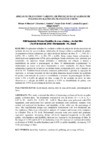Please use this identifier to cite or link to this item:
http://www.alice.cnptia.embrapa.br/alice/handle/doc/1013781| Title: | Adição de óleo como variável de predição da qualidade de peletes em rações de frangos de corte. |
| Authors: | MARCON, W. A.  KRABBE, E. L.   AVILA, V. S. de   LOPES, L. dos S.   SUREK, D.   |
| Affiliation: | WILSON A. MARCON, FACC; EVERTON LUIS KRABBE, CNPSA; VALDIR SILVEIRA DE AVILA, CNPSA; LETICIA DOS SANTOS LOPES, CNPSA; DIEGO SUREK, CNPSA. |
| Date Issued: | 2014 |
| Citation: | In: SEMINÁRIO INTERNACIONAL DE AVES E SUÍNOS, 15.; SEMINÁRIO TÉCNICO CIENTÍFICO DE AVES E SUÍNOS; FEIRA DA INDÚSTRIA LATINO-AMERICANA DE AVES E SUÍNOS, 2014, Florianópolis. Anais... Florianópolis: Gessulli, 2014. AVESUI 2014. |
| Description: | No presente trabalho foi avaliado o efeito da adição de níveis crescentes de inclusão de óleo de soja em dietas peletizadas de frangos sobre a qualidade do pelete. Os tratamentos foram compostos por cinco níveis de inclusão de óleo: T1 ?1,74%; T2 ?2,87%; T3?4,01%; T4 ?5,15%; T5 ?6,28%. Estas dietas foram submetidas à peletização em equipamento CPM, após a produção foram coletadas cinco amostras por tratamento. As amostras foram resfriadas e analisadas em relação à dureza e durabilidade do pelete e porcentagem de finos. O delineamento experimental foi inteiramente ao acaso com cinco tratamentos e cinco repetições. Os dados foram submetidos à análise de variância e as médias foram comparadas pelo teste t -Student, ao nível de 5%. Também foram testados contrastes polinomiais e geradas as equações de regressão.A inclusão crescente de óleo na dieta impactou negativamente na qualidade do pelete, com redução da dureza e durabilidade e aumento na porcentagem de finos. Entre 1,74% e 6,28% de adição de óleo, a cada 1% de aumento no nível de óleo, observou-se a redução de 0,86% na dureza e 4,43% na durabilidade do pelete, com aumento de 3,55% na porcentagem de finos na ração. This study evaluated the effect of increasing soybean oil levels on pellet qualityin broiler diets. The treatments consisted of five oil levels:T1 ?1.74 %, T2 ?2.87 %; T3 ?4.01%, T4 ?5.15%; T5 ?6.28 %. These diets were pelletized with CPM equipment, after production five samples per treatment were collected. Samples were cooled and analyzed for hardness and durability of the pellet and the percentage of fines. The experimental design was complete ly randomized with five treatments and five replicates. Data were subjected to analysis of variance and means were compared by t-Student Test at 5% level. Polynomial contrasts were also tested and generated regression equations. I ncreasing dietary oil levels impacted negatively on the pellet quality, with hardness and durability decrease and increase in the percentage of fines. the range of 1 .74% and 6. 28 % oil inclusion , every 1% increas e of soybean oil resulted in decrease of 0.86% in pellet hardness and 4. 43% in pellet durabi lity , increasing 3. 55 % the percentage of fines . |
| Thesagro: | Avicultura Óleo Peletização |
| Keywords: | Óleo de soja |
| Type of Material: | Artigo em anais e proceedings |
| Access: | openAccess |
| Appears in Collections: | Artigo em anais de congresso (CNPSA)  |
Files in This Item:
| File | Description | Size | Format | |
|---|---|---|---|---|
| final7444.pdf | 263,03 kB | Adobe PDF |  View/Open |









